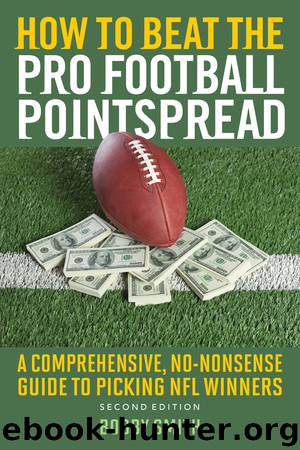How to Beat the Pro Football Pointspread by Bobby Smith

Author:Bobby Smith
Language: eng
Format: epub
Publisher: Skyhorse Publishing
Published: 2014-12-31T16:00:00+00:00
FIGURE 10-1 Minnesota Vikings
The Vikings struck me as a very strong opportunity—with the 5-11 ATS record as a bonus public diversion, a red herring. In being rebuilt by head coach Brad Childress, Minnesota was not constructed like the typical team whose home is indoors in a dome. They were big on the offensive line, and concentrated on running the ball, not passing. In Childress’s first two seasons, their average game split on offense made this change:
These Vikings were not the St. Louis Rams, New Orleans Saints, or Indianapolis Colts, home-dome teams with speedy receivers on artificial turf whose quarterbacks often threw for 300 yards per game and averaged 260-270 aerial yards per outing. The Vikings had less than ordinary receivers. Their #1 quarterback Tarvaris Jackson still hadn’t played a full pro season and had a long way to go before he would ever be a consistently good playmaker. But the increase in rushing yards from the season prior—up to 160 rushing yards per game—at the expense of 34 fewer passing yards and 6 fewer passing attempts per game—was being triggered by a standout rookie running back, Adrian Peterson, supported by last season’s capable first-string running back Chester Taylor, behind that large and good run-blocking offensive line.
To complement the offense’s ability to gain rushing yards, the Vikings’ defense was, for the second straight season, allowing an NFL-low rushing yards, fewer than 75 per game.
Clearly, Minnesota had an identity: “Run, Stop the Run.” This was an inarguable fact, because they were rushing for the most yards and allowing the least. Until further notice—when their group of skill players either matured or re-stocked—Minnesota was playing the Run, Stop the Run card. If an opponent could trump it, so be it.
If there was an offense with less potential in its passing game than Minnesota’s, it was San Francisco’s. “As Gore goes, so goes the offense,” was a very common refrain about this particular 49ers team, in reference to their #1 running back. The 49ers’ home field was notorious for being long, soft grass, to nullify opposing wide-receiver speed and accent their own between-tackles running game. The playing surface was actually very conducive to the way the road team wanted to play! With San Francisco’s offense averaging only 94 rushing yards per game, Gore hadn’t been going anyplace special. Matched up against a defense proven to be elite in Stop the Run, the likelihood of Gore going anywhere but nowhere on this particular afternoon was pretty slim.
The 49ers offense had no real identity. At only 94 rushing yards per game, they were 10 yards below the NFL median while Minnesota was 52 yards above it. With only 163 passing yards per game—rock bottom in the NFL—the likelihood of San Francisco offsetting the rushing yard deficit with big pass plays was slim. The numbers said so. Boiling it all down further, San Francisco’s offense was logging only 53 plays per game, to Minnesota’s 58, and getting only 13 first downs per game, to Minnesota’s 17. While
Download
This site does not store any files on its server. We only index and link to content provided by other sites. Please contact the content providers to delete copyright contents if any and email us, we'll remove relevant links or contents immediately.
Harry Potter and the Cursed Child: The Journey by Harry Potter Theatrical Productions(3991)
The Sports Rules Book by Human Kinetics(3599)
Molly's Game: From Hollywood's Elite to Wall Street's Billionaire Boys Club, My High-Stakes Adventure in the World of Underground Poker by Molly Bloom(2977)
A Knight of the Seven Kingdoms by George R R Martin(2638)
Quidditch Through the Ages by J.K. Rowling(2613)
Quidditch Through the Ages by J K Rowling & Kennilworthy Whisp(2589)
How To by Randall Munroe(2500)
Quidditch Through the Ages by Kennilworthy Whisp by J.K. Rowling(2454)
Quidditch through the Ages by J. K. Rowling(2387)
Quidditch Through The Ages by J. K. Rowling(2346)
Stacked Decks by The Rotenberg Collection(2285)
The Infinite Retina by Robert Scoble Irena Cronin(2284)
776 Stupidest Things Ever Said by Ross Petras(2282)
What If?: Serious Scientific Answers to Absurd Hypothetical Questions by Randall Munroe(2179)
Flowers For Algernon by Daniel Keyes(2172)
Beautiful Oblivion by Jamie McGuire(2157)
The Book of Questions: Revised and Updated by Gregory Stock Ph.d(2146)
Ready Player One: A Novel by Ernest Cline(2084)
Champions of Illusion by Susana Martinez-Conde & Stephen Macknik(2081)
